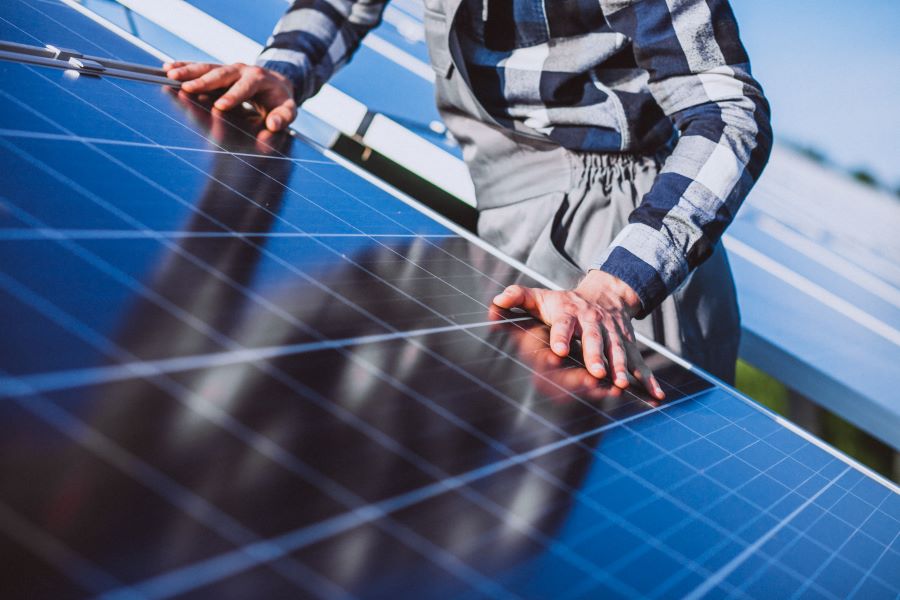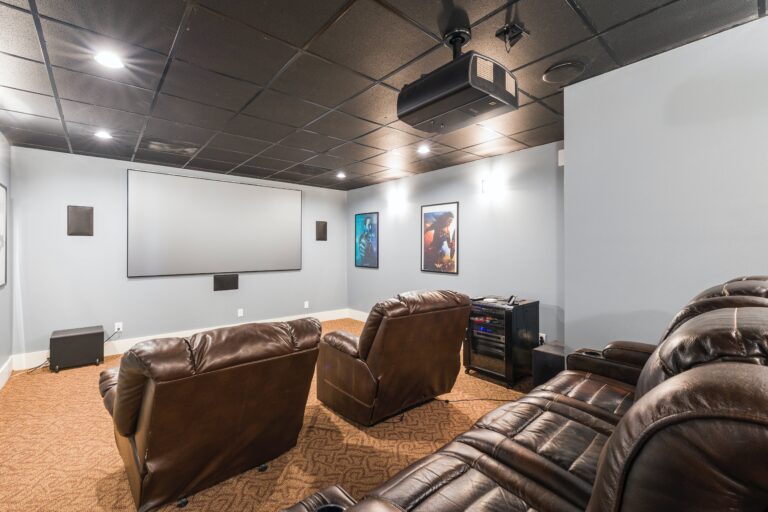
Home Owners Federal Income Tax Credits and Incentives for Energy Efficiency
Discover the financial benefits of energy efficiency programs and incentives for smart homeowners. Explore how implementing energy-saving measures can lead to long-term savings that quickly pay for themselves.
Learn about available programs, incentives, and rebates that can help you reduce energy costs, increase home value, and contribute to a greener future. We will cover topics such as federal income tax credits, financing energy-efficient homes, weatherization assistance, low-income energy programs, and manufacturers rebate programs for energy-efficient upgrades.
Discover how frugal folks can make a positive impact while putting extra cash in their pocket.
Federal Income Tax Credits and Incentives for Energy Efficiency
One of the most beneficial ways to save money while making your home more energy-efficient is by taking advantage of federal income tax credits and incentives. These programs are designed to encourage homeowners to invest in energy-saving upgrades, such as renewable energy systems and energy-efficient appliances.
Residential Renewable Energy Tax Credit
The Residential Renewable Energy Tax Credit is a federal tax credit that allows homeowners to claim a percentage of the costs associated with installing qualified renewable energy systems in their homes. The eligible systems include solar panels, wind turbines, geothermal heat pumps, and fuel cell systems.
The tax credit covers a portion of the installation costs, including equipment, labor, and related expenses. The credit amount varies depending on the type of system and the year of installation. It is important to note that the tax credit has a gradual phase-out schedule, so the percentage of the credit may decrease over time.
To claim the Residential Renewable Energy Tax Credit, you must file IRS Form 5695 along with your annual tax return. Be sure to keep all receipts, invoices, and documentation related to the installation to support your claim. Form is only 2 pages, however I suggest to consult with a tax professional or visit the IRS website for the most up-to-date information on eligibility criteria and credit percentages.
Energy-Efficient Home Improvements Deductions
In addition to the Residential Renewable Energy Tax Credit, homeowners may also qualify for deductions on energy-efficient home improvements. These deductions allow you to reduce your taxable income based on the costs incurred for eligible upgrades.
Common examples of energy-efficient home improvements that may qualify for deductions include insulation, energy-efficient windows and doors, HVAC systems, and roofing. The specific criteria and maximum deduction amounts may vary, so it is important to review the IRS guidelines.
To claim these deductions, you will need to complete IRS Form 5695 and submit it along with your tax return.
Non-Business Energy Property Credit
The Non-Business Energy Property Credit is another federal tax credit available to homeowners who make qualified energy-efficient improvements to their primary residences. This credit covers installation of energy-efficient windows, doors, insulation, and certain heating and cooling systems.
The credit amount is calculated as a percentage of the cost of the qualified improvements, up to a specified limit. It is important to note that the Non-Business Energy Property Credit has expired in the past but has been extended multiple times through legislation. Therefore, it is essential to check the current status of the credit before planning your energy-efficient upgrades.
To claim the Non-Business Energy Property Credit, you will need to complete IRS Form 5695 and submit it with your tax return. Ensure that you have all the necessary documentation, such as receipts and manufacturer certifications, to support your claim.
Residential Energy Efficient Property Credit
The Residential Energy Efficient Property Credit offers a federal tax credit for homeowners who invest in qualified renewable energy systems for their homes. This credit covers expenses related to solar electric systems, solar water heating systems, small wind turbines, and geothermal heat pumps.
The credit allows you to claim a percentage of the costs associated with the installation and equipment, including labor expenses. The percentage of the credit and maximum allowable credit amount may vary depending on the type of system and the year of installation.
To claim the Residential Energy Efficient Property Credit, you will need to complete IRS Form 5695 and submit it with your tax return. It is crucial to retain all necessary documentation, such as invoices, receipts, and manufacturer certifications, to support your claim.
How to Maximize Your Benefits
To maximize the benefits of federal income tax credits and incentives for energy efficiency, there are a few key steps you can take:
- Research Eligibility: Before making any energy-efficient upgrades, familiarize yourself with the eligibility criteria for each tax credit and incentive program. This will help you determine which upgrades qualify and the documentation required for claiming the credits.
- Plan Ahead: Energy-efficient improvements can require careful planning. Consider the timing of your upgrades to ensure they align with the deadlines and availability of tax credits. Some credits have expiration dates or phase-out schedules, so planning ahead can help you maximize your savings.
- Keep Detailed Records: It is crucial to maintain accurate records of all expenses related to your energy-efficient upgrades. Keep receipts, invoices, and any supporting documentation to substantiate your claims when filing your taxes. This will help you avoid any potential issues during the auditing process.
- Consult a Tax Professional: Tax laws and regulations can be complex and subject to change. Consulting a qualified tax professional can ensure that you understand the specific requirements and maximize your benefits. They can provide guidance tailored to your unique situation and help you navigate the tax filing process.
By taking advantage of federal income tax credits and incentives for energy efficiency, you can not only reduce your energy consumption and lower your utility bills but also save money on your tax bill. These programs serve as incentives for homeowners to invest in energy-saving upgrades, benefiting both your wallet and the environment.
Remember to visit the IRS website or a tax professional for the most up-to-date information and guidance on eligibility criteria, credit percentages, and documentation requirements. Act now to make your home more energy-efficient and enjoy the financial rewards of these programs.
How have government and businesses impacted energy efficiency?
Energy efficiency has become a crucial aspect of sustainable development in recent years, with governments and businesses playing pivotal roles in driving positive change. In this article, we will explore the significant impacts these entities have had on energy efficiency, highlighting their achievements and initiatives.
Government Initiatives:
- Regulatory Frameworks: Governments worldwide have implemented stringent energy efficiency standards and regulations to encourage businesses to adopt energy-saving practices.
- Incentive Programs: Governments offer financial incentives, such as tax credits and grants, to businesses that invest in energy-efficient technologies and practices.
- Energy Efficiency Policies: Governments have introduced policies that promote energy-efficient building codes, appliance labeling, and energy audits to increase awareness and adoption of energy-saving measures.
- Research and Development Funding: Governments allocate resources to support research and development in energy-efficient technologies, fostering innovation and driving advancements in this field.
Business Contributions:
- Corporate Social Responsibility (CSR): Many businesses have embraced energy efficiency as part of their CSR initiatives, recognizing the importance of reducing carbon footprints and promoting sustainable practices.
- Energy Management Systems: Businesses implement energy management systems to monitor and optimize energy consumption across their operations, reducing waste and improving efficiency.
- Energy Audits: Businesses conduct regular energy audits to identify areas of improvement and implement energy-saving measures, leading to reduced energy consumption and cost savings.
- Renewable Energy Integration: Businesses are increasingly investing in renewable energy sources, such as solar and wind, to power their operations, minimizing reliance on fossil fuels and reducing greenhouse gas emissions.
Government-Business Collaboration:
- Public-Private Partnerships: Governments collaborate with businesses through public-private partnerships to develop and implement energy efficiency programs, leveraging their respective expertise and resources.
- Technology Deployment: Governments work with businesses to deploy energy-efficient technologies at scale, facilitating widespread adoption and maximizing impact.
- Knowledge Sharing: Governments and businesses engage in knowledge-sharing initiatives, exchanging best practices and success stories to accelerate the adoption of energy-efficient practices across industries.
The combined efforts of governments and businesses have had a profound impact on energy efficiency, driving significant progress towards a more sustainable future. Through regulatory frameworks, financial incentives, technology deployment, and collaborative partnerships, these entities have successfully encouraged the adoption of energy-efficient practices, reducing energy consumption, and mitigating the environmental impact. As we move forward, continued collaboration and innovation will be essential in further advancing energy efficiency and achieving long-term sustainability goals.
Financing Energy Efficient Homes
Investing in energy-efficient upgrades for your home not only helps you save on energy costs but also contributes to a greener and more sustainable future. However, the upfront costs of these upgrades can sometimes be a barrier for homeowners. That’s where financing options for energy-efficient homes come into play. Here are some ways you can secure financing to make your home more energy-efficient.
Energy-Efficient Mortgages
Energy-efficient mortgages (EEMs) are specialized loan programs that allow homebuyers or homeowners to finance energy-efficient improvements as part of their mortgage. Increase the purchasing power despite higher debt-to-income and housing expense-to-income ratios.
With an EEM, you can include the cost of energy-efficient improvements, such as insulation, windows, HVAC systems, and solar panels, in your mortgage loan. The additional funds can be used to cover the upfront costs of the upgrades, making it easier to finance energy-efficient improvements without a substantial financial burden.
To qualify for an energy-efficient mortgage, lenders typically require an energy assessment or an energy audit to determine the potential energy savings resulting from the planned upgrades. The projected savings are then factored into the loan approval process.
Home Improvement Loans
Home improvement loans are another popular option for financing energy-efficient upgrades. These loans are specifically designed to cover the costs of home improvements, including energy-saving projects. There are various types of home improvement loans available, each with its own terms and requirements.
- Personal Loans: Personal loans are unsecured loans that can be used for various purposes, including home improvements. They typically have higher interest rates than other loan options, but they offer flexibility in terms of repayment and loan amounts.
- Home Equity Loans: Home equity loans allow homeowners to borrow against the equity they have built in their homes. These loans often come with fixed interest rates and longer repayment terms, making them a popular choice for financing larger energy-efficient projects.
- Home Equity Lines of Credit (HELOC): HELOCs are lines of credit that use the home as collateral. They provide homeowners with a revolving line of credit, allowing them to borrow as needed for energy-efficient upgrades. Interest rates may be variable, and repayment terms can vary.
Should you consider home improvement loans, it is important to compare the interest rates, repayment terms, and any associated fees. Shop around for the best loan options and consult with lenders to understand the specific requirements and eligibility criteria.
Property-Assessed Clean Energy (PACE) Programs
Property-Assessed Clean Energy (PACE) programs provide homeowners with financing options for energy-efficient upgrades by allowing them to borrow against the equity in their properties. PACE programs offer long-term, fixed-rate loans that are repaid through assessments on the homeowner’s property tax bill.
These loans are attached to the property, rather than the homeowner, and are repaid over an extended period. This feature allows homeowners to transfer the loan obligation to subsequent property owners if they decide to sell their homes.
PACE programs typically cover a range of energy-efficient improvements, such as solar installations, energy-efficient HVAC systems, and insulation upgrades. Eligibility and program details vary by state and locality, so it’s important to research and understand the specific requirements in your area.
Energy-Efficient Financing Programs
Many states, local governments, and utility companies offer energy-efficient financing programs to incentivize homeowners to invest in energy-saving upgrades. These programs often provide low-interest loans, rebates, or other financial incentives to help homeowners make their homes more energy-efficient.
These financing programs vary by location, so it’s important to research the offerings available in your area. Check with your local energy utility provider, government agencies, or visit energy efficiency websites to find information on available programs and eligibility requirements.
Energy Efficiency Rebate Programs
In addition to loans and mortgages, many utility companies and government entities offer energy efficiency rebate programs to incentivize homeowners to invest in energy-saving upgrades. These programs provide financial incentives in the form of rebates or incentives for specific energy-efficient products or services.
Rebates can help offset the upfront costs of energy-efficient upgrades, making them more affordable for homeowners. Some common examples of rebate programs include:

Appliance Rebates: Many utility companies offer rebates for purchasing energy-efficient appliances, such as refrigerators, dishwashers, or washing machines. These rebates can help lower the cost of replacing old, inefficient appliances with energy-saving models.
- HVAC System Rebates: Upgrading to an energy-efficient HVAC system can significantly reduce energy consumption and utility bills. Utility companies often provide rebates for installing high-efficiency heating and cooling systems or conducting HVAC system tune-ups.
- Insulation and Weatherization Rebates: Improving the insulation and weatherization of your home can enhance energy efficiency. Rebate programs may offer incentives for adding insulation, sealing air leaks, or upgrading windows and doors.
- Renewable Energy Rebates: Installing solar panels or other renewable energy systems can be a significant investment. Rebate programs for renewable energy incentivize homeowners to embrace sustainable energy sources by offering financial incentives to offset the installation costs.
To access these rebate programs, visit the websites of your local utility companies, government energy departments, or energy efficiency organizations. They typically provide detailed information on available rebate programs, eligibility requirements, and application processes.
The Energy Efficiency of Electric Heaters: Comprehensive Overview
Electric heaters are widely used for heating purposes, but their energy efficiency is a crucial factor to consider. We will explore the energy efficiency of electric heaters, providing concise and impactful information to help you make informed decisions about your heating needs.
-
Understanding Energy Efficiency:
- Energy Efficiency Ratio (EER): EER measures the efficiency of an electric heater by comparing the amount of heat output (in BTUs) to the amount of electricity consumed (in watts).
- Coefficient of Performance (COP): COP is another metric used to assess energy efficiency, specifically for heat pumps. It measures the amount of heat output versus the electrical power input.
-
Factors Affecting Energy Efficiency:
- Insulation: Proper insulation in your home or space helps retain heat, reducing the workload on the electric heater and improving overall energy efficiency.
- Heating Capacity: Electric heaters come in various sizes and heating capacities. Choosing the right-sized heater ensures optimal performance and energy efficiency.
- Thermostat Control: Electric heaters equipped with programmable thermostats allow precise temperature control, preventing overheating and unnecessary energy consumption.
-
Types of Electric Heaters and Their Energy Efficiency:
- Convection Heaters: These heaters warm the air in a room through natural convection. While they are effective for heating small spaces, they may not distribute heat evenly, potentially leading to energy wastage.
- Radiant Heaters: Radiant heaters emit infrared radiation that directly heats objects and people in their path. They provide instant heat but are less effective in heating larger areas.
- Heat Pumps: Heat pumps are highly energy-efficient electric heaters that transfer heat from the outside air or ground to warm indoor spaces. They can achieve a high COP, making them a cost-effective heating option.
-
Energy-Saving Tips for Electric Heaters:
- Proper Placement: Position the electric heater in the area you want to heat, away from drafts or obstructions that may hinder heat distribution.
- Timers and Thermostats: Utilize programmable timers and thermostats to regulate heating cycles and maintain desired temperatures efficiently.
- Supplementary Insulation: Enhance the energy efficiency of your electric heater by adding insulation to walls, windows, and doors to prevent heat loss.
-
Considerations for Energy Efficiency:
- Energy Star Certification: Look for electric heaters with Energy Star certification, indicating they meet stringent energy efficiency standards set by regulatory bodies.
- Energy Consumption Labels: Check the energy consumption labels on electric heaters to compare their energy efficiency ratings and make informed choices.
When it comes to electric heaters, understanding their energy efficiency is vital for optimizing performance while minimizing energy consumption. By considering factors such as insulation, heating capacity, and thermostat control, and exploring different types of electric heaters, you can make informed decisions to achieve both comfort and energy savings.
Assistance with Weatherization and Energy Costs
One of the challenges homeowners often face is high energy costs. The expenses associated with heating, cooling, and maintaining a comfortable home can put a strain on household budgets, especially for low-income families. However, there are various assistance programs available to help homeowners with weatherization and energy costs, ensuring that everyone has access to affordable and efficient energy solutions.
- Weatherization Assistance Program (WAP)
The Weatherization Assistance Program (WAP) is a federally funded program designed to assist low-income households in improving the energy efficiency of their homes. The program provides grants to states, territories, and tribal governments, who then allocate funds to local agencies to perform weatherization upgrades.
Under the WAP, eligible homeowners can receive free or low-cost weatherization services, such as insulation installation, air sealing, and heating system improvements. These measures help reduce energy consumption, lower utility bills, and improve the overall comfort of homes.
To qualify for the Weatherization Assistance Program, households must meet certain income guidelines based on the federal poverty level. Additionally, priority is given to households with elderly members, individuals with disabilities, and families with young children.
To access the Weatherization Assistance Program in your area, contact your local Community Action Agency or state energy office. They can provide information on eligibility requirements, application processes, and the available weatherization services.
- Low-Income Home Energy Assistance Program (LIHEAP)
The Low-Income Home Energy Assistance Program (LIHEAP) is another valuable resource for homeowners struggling with high energy costs. LIHEAP provides financial assistance to low-income households to help them meet their immediate home energy needs, including heating and cooling expenses.
Through LIHEAP, eligible homeowners can receive assistance in the form of grants or credits applied directly to their energy bills. The program aims to ensure that low-income households can afford the energy necessary for maintaining a safe and healthy living environment.
The eligibility requirements for LIHEAP vary by state, as the program is administered at the state level. Typically, income and household size are considered when determining eligibility. To apply for LIHEAP, individuals can contact their local LIHEAP office or Community Action Agency for information on the application process.
- State and Local Energy Assistance Programs
In addition to federal assistance programs like WAP and LIHEAP, many states and local governments offer their own energy assistance programs. These programs may include financial assistance, energy education, and weatherization services.
State and local energy assistance programs can vary in terms of eligibility criteria, services provided, and funding availability. It’s important to research the programs specific to your location to understand the options and requirements.
To find information about state and local energy assistance programs, visit the website of your state energy office or contact your local government’s housing or community development department.
- Utility Company Assistance Programs
Many utility companies offer assistance programs to help customers manage their energy costs. These programs can include bill payment assistance, energy efficiency incentives, and budget billing options.
Contact your utility company directly or visit their website to inquire about the available assistance programs. They can provide you with details on eligibility requirements, application processes, and the benefits offered.
- Energy Education and Conservation Programs
In addition to financial assistance, energy education and conservation programs can help homeowners reduce their energy consumption and save money on energy bills. These programs provide valuable information and resources on energy-efficient practices, tips for reducing energy waste, and advice on selecting energy-saving appliances and equipment.
Check with your local energy efficiency organizations, community centers, or utility companies for educational resources and workshops. These programs often provide valuable insights into energy-saving techniques and may even offer free or discounted energy-efficient products.
FAQs
- Q: Can I receive weatherization assistance if I am not low-income?
A: Weatherization assistance programs primarily target low-income households. However, some programs may have eligibility criteria based on income brackets. It’s best to check with your local Community Action Agency or state energy office to determine if there are any weatherization programs available for homeowners who are not low-income.
- Q: How much financial assistance can I receive through LIHEAP?
A: The amount of financial assistance provided through the Low-Income Home Energy Assistance Program (LIHEAP) varies depending on factors such as income, household size, and energy costs. The program aims to provide assistance that helps eligible households meet their immediate energy needs. The specific amount of assistance you may receive can be determined by contacting your local LIHEAP office or Community Action Agency.
- Q: Are there income limits for state and local energy assistance programs?
A: State and local energy assistance programs may have income limits to determine eligibility. These limits can vary depending on the specific program and location. To find out the income limits for state and local energy assistance programs in your area, it is recommended to visit the website of your state energy office or contact your local government’s housing or community development department.
- Q: Can I participate in utility company assistance programs if I rent my home?
A: Utility company assistance programs are often available to both homeowners and renters. However, eligibility requirements may vary, and it’s important to check with your utility company to understand the specific criteria. Renters may need to provide documentation, such as a lease agreement, to demonstrate their eligibility for the assistance programs.
- Q: How can I learn more about energy-saving practices and conservation programs?
A: To learn more about energy-saving practices and conservation programs, you can reach out to your local energy efficiency organizations, community centers, or utility companies. They often offer educational resources, workshops, and information on energy-efficient practices. Additionally, online resources and government websites can provide valuable information on energy-saving tips and techniques.
- Q: Are these assistance programs available nationwide?
A: While some assistance programs like the Weatherization Assistance Program (WAP) and the Low-Income Home Energy Assistance Program (LIHEAP) are federally funded and available in all states, the specific availability and details of state and local energy assistance programs may vary. It’s important to research the programs available in your area by contacting your local agencies or visiting the websites of your state energy office, utility companies, and government departments.
- Low-Income Home Energy Assistance Program (LIHEAP)
The Low-Income Home Energy Assistance Program (LIHEAP) is a vital resource for individuals and families who struggle with high energy costs and face challenges in meeting their home energy needs. LIHEAP provides financial assistance to eligible low-income households to help them afford their heating and cooling expenses, ensuring that they can maintain a safe and comfortable living environment.
- Heating and Cooling Assistance
LIHEAP primarily focuses on providing assistance with heating and cooling expenses. The program offers various forms of support, including bill payment assistance, energy crisis intervention, and energy-related home repairs.
Through LIHEAP, eligible households can receive financial aid to help offset the costs of heating and cooling their homes. This assistance can be in the form of grants or credits that are applied directly to their energy bills, helping to reduce the financial burden associated with energy consumption.
- Eligibility and Application Process
Eligibility for LIHEAP is based on several factors, including income, household size, and the availability of funds. The program primarily targets low-income households, with priority given to those with the greatest energy needs, such as the elderly, individuals with disabilities, and families with young children.
To apply for LIHEAP, individuals can contact their local LIHEAP office or Community Action Agency. The application process typically involves providing documentation to verify income, residency, and energy expenses. This may include proof of income, utility bills, and identification documents.
It’s important to note that LIHEAP is administered at the state level, and each state may have its own guidelines and procedures. Therefore, it is crucial to reach out to the appropriate local agency or visit the state’s LIHEAP website to understand the specific requirements and application deadlines in your area.
- Crisis Intervention
LIHEAP also offers crisis intervention services for households facing immediate energy-related emergencies. These emergencies may include situations where a household’s energy source has been shut off, or there is a risk of utility disconnection due to non-payment.
Through crisis intervention, LIHEAP provides assistance to eligible households to prevent energy service disruptions or restore services that have been shut off. This support ensures that vulnerable individuals and families can maintain a safe and habitable living environment, especially during extreme weather conditions.
- Energy Education and Weatherization
In addition to financial assistance, LIHEAP may also offer energy education and weatherization services. Energy education programs provide valuable information and resources to help individuals and families understand energy-efficient practices, reduce energy waste, and make informed decisions about energy usage.
Weatherization services focus on improving the energy efficiency of homes by implementing measures such as insulation, air sealing, and heating system upgrades. These services help to reduce energy consumption, lower utility bills, and improve overall comfort and energy efficiency.
How Customers Can Benefit Financially from the Listed Programs and Rebates
Now that we have explored the various programs and rebates available for energy efficiency, let’s discuss how customers can benefit financially from them. By participating in these initiatives, you can experience both short-term and long-term financial advantages.
- Reduced Energy Bills: Energy-efficient upgrades, such as insulation, efficient appliances, and solar panels, can significantly lower your monthly energy bills. By consuming less energy, you’ll see a noticeable decrease in your utility expenses, saving you money each month.
- Tax Savings: Federal income tax credits allow you to deduct a portion of your energy-efficient upgrade costs from your tax liability. This means that you’ll owe less in taxes or even receive a refund. Be sure to consult a tax professional or visit the IRS website to understand the specific tax credits available to you.
- Lower Financing Costs: If you choose to finance your energy-efficient upgrades, opting for specialized energy-efficient loans can save you money in the long run. These loans often come with lower interest rates and favorable terms, reducing your overall financing costs.
- Rebate Benefits: Manufacturers rebate programs provide direct financial incentives for purchasing energy-efficient products or completing qualifying home improvements. By taking advantage of these rebates, you can receive partial reimbursement for your expenses, effectively lowering the upfront costs.
- Improved Home Value: Energy-efficient upgrades not only save you money but also increase the value of your home. When it comes time to sell, having energy-efficient features can attract buyers and potentially fetch a higher sale price.
How to Access Programs Online for Up-to-Date Information
Accessing programs online for up-to-date information is essential to stay informed about the latest updates, eligibility requirements, application processes, and deadlines. By utilizing online resources, homeowners can easily access the information they need to make informed decisions and take advantage of the available energy efficiency programs. Here are some steps to access these programs online:
- Start with Government Websites:
Government websites are a valuable source of information when it comes to energy efficiency programs. Visit the official websites of federal, state, and local government agencies responsible for energy and environment-related initiatives. These websites often provide comprehensive information about various programs, including tax credits, incentives, financing options, and assistance programs.
Look for dedicated sections or pages on energy efficiency or residential programs. These pages typically provide detailed program descriptions, eligibility criteria, application guidelines, and contact information. Some government websites also feature interactive tools or calculators to help homeowners assess their potential savings or eligibility for specific programs.
- Explore Energy Efficiency Organizations:
Energy efficiency organizations play a crucial role in promoting and facilitating energy-saving initiatives. Many organizations maintain informative websites that offer resources and information on available programs. These organizations can be at the national, regional, or local level.
Start by researching reputable energy efficiency organizations such as the U.S. Department of Energy (DOE), Energy Star, Alliance to Save Energy, or local utility companies. These organizations often provide valuable insights, program listings, and resources to help homeowners navigate through the available options.
- Check Manufacturer Websites:
For specific energy-efficient products or appliances, manufacturers often offer rebate programs or incentives directly to customers. Visit the websites of manufacturers that produce energy-efficient products you are interested in. Look for dedicated sections related to rebates, promotions, or incentives.
Manufacturer websites typically provide detailed information about eligible products, rebate amounts, and application procedures. Some websites even have online tools to help homeowners find local retailers or contractors participating in the rebate programs. Make sure to review the terms and conditions of the rebate programs and any documentation required for the application process.
- Subscribe to Newsletters and Email Updates:
To stay up-to-date with the latest information and announcements, consider subscribing to newsletters or email updates from relevant government agencies, energy efficiency organizations, and manufacturers. These subscriptions often provide timely notifications about new programs, changes in eligibility criteria, upcoming deadlines, and other important updates.
- Utilize Online Search Engines:
Search engines are a powerful tool for finding specific information about energy efficiency programs. Use relevant keywords such as “energy efficiency programs,” “rebates for energy-efficient upgrades,” or “government tax credits for energy efficiency” to search for available programs in your area.
To access the programs mentioned in this article and stay informed about the latest updates, it’s crucial to utilize online resources. Here are some websites where you can find comprehensive information about each program:
- Federal Income Tax Credits and Incentives for Energy Efficiency: Visit the official website of the Internal Revenue Service (IRS) at www.irs.gov for detailed information on energy-related tax credits and incentives.
- Financing Energy Efficient Homes: Explore the websites of financial institutions, such as banks and credit unions, that specialize in energy-efficient financing. They often provide detailed information about available loan programs and their terms.
- Assistance with Weatherization and Energy Costs: The Department of Energy (DOE) website at www.energy.gov offers resources and links to state-specific weatherization assistance programs. You can also check the Department of Housing and Urban Development (HUD) website at www.hud.gov for additional information.
- Low-Income Home Energy Assistance Program (LIHEAP): The Administration for Children and Families (ACF) website at www.acf.hhs.gov provides detailed information about LIHEAP, including eligibility criteria and application procedures. You can also contact your local community action agency for further assistance.
- Manufacturers Rebate Programs for Energy Efficient Upgrades: Visit the websites of manufacturers of energy-efficient products you are interested in or consult with local retailers to learn about available rebate programs. Each manufacturer typically has a dedicated section on their website providing detailed information about eligibility and how to claim rebates.
Frequently Asked Questions (FAQs)
- Q: Are federal income tax credits and incentives available to everyone?
- A: Federal income tax credits and incentives for energy efficiency have specific eligibility criteria. It’s essential to review the guidelines provided by the IRS to determine if you qualify for these benefits.
- Q: How can I find out if I qualify for financing options for energy-efficient homes?
- A: Research financial institutions that offer energy-efficient loans and compare their terms and eligibility requirements. Contact them directly or visit their websites for detailed information.
- Q: What kind of services are provided through weatherization assistance programs?
- A: Weatherization assistance programs can include insulation installation, air leak sealing, heating and cooling system improvements, and other energy-saving measures to make your home more comfortable and energy-efficient.
- Q: How can I apply for LIHEAP assistance?
- A: Visit the ACF website or contact your local community action agency to learn about the application process, eligibility criteria, and required documentation for LIHEAP.
- Q: What types of products qualify for manufacturers rebate programs?
- A: Energy-efficient appliances, smart thermostats, LED lighting, and HVAC systems are some examples of products that may be eligible for manufacturers rebate programs. Visit the manufacturers’ websites for specific information.
- Q: Can I combine multiple programs and incentives to maximize my savings?
- A: In some cases, you may be eligible for multiple programs and incentives simultaneously. However, it’s essential to review the guidelines of each program to understand any limitations or restrictions.
Conclusion
Congratulations! You’ve learned about various programs and incentives that can help you save money while promoting energy efficiency. From federal income tax credits to financing options, weatherization assistance, low-income energy programs, and manufacturers rebate programs, there are numerous opportunities to benefit financially.






